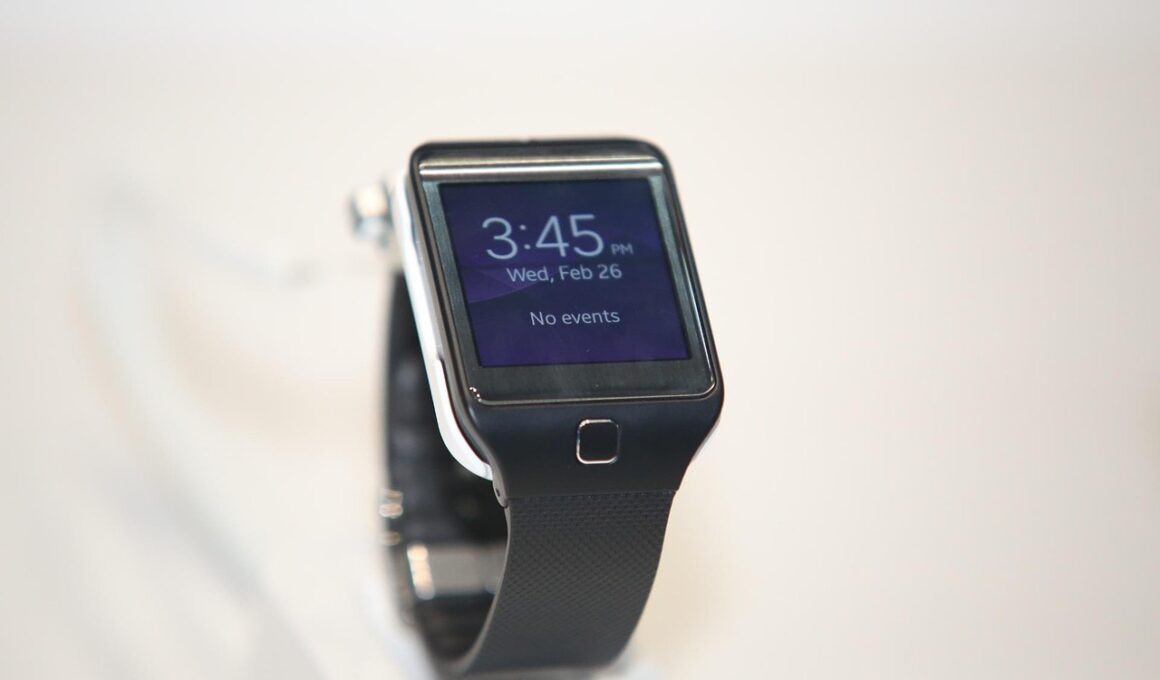Integrating Wearable Devices with Body Measurement Apps
The fusion of wearable devices with body measurement apps is revolutionizing the fitness industry, offering users enhanced tracking capabilities. These devices, often worn on the wrist or placed in clothing, can collect vital fitness data, including heart rate, calories burned, and step count. When synchronized with body measurement apps, they provide comprehensive insights into one’s physical body composition changes over time. Users can harness this integration to set realistic fitness goals, track their progress efficiently, and stay motivated. Additionally, the convenience factor is significant; having all fitness metrics in one place simplifies user experience. Popular wearables such as smartwatches and fitness bands connect to mobile applications, allowing for a seamless transition between measurement and tracking. Users no longer need multiple devices for various functions. Instead, they receive notifications, reminders, and personalized coaching right on their wrists. This leads to increased accountability and makes reaching fitness milestones a more realistic attainment. Furthermore, most apps allow data sharing among friends, which promotes a competitive spirit and community support, making the overall fitness journey enjoyable and interactive for individuals and groups alike.
Body measurement apps work by collecting detailed body composition data, including weight, body fat percentage, and muscle mass. This precise information complements the real-time data captured by wearables, offering users a complete overview of their health progress. Users can also input specific goals within these apps, which helps maintain focus and motivation. With the increase of smartphone users globally, these apps have become more accessible, leading to a notable rise in user engagement. Integration with wearable devices further enhances the user experience by providing automatic updates without manual entries. This not only saves time but also reduces user errors during tracking. Many apps also provide graphical representations of users’ progress over time, which visualizing data helps in understanding trends effectively. Additionally, many of these apps now feature a social component, allowing users to share their journeys and achievements, which strengthens community bonds. With this added layer of social interaction, users might find themselves more physically active, thanks to accountability and friendly competition. All this ultimately contributes to a healthier lifestyle, making fitness tracking much easier and more enjoyable for everyone involved.
When integrating wearable technology with body measurement apps, data accuracy becomes crucial. Before choosing a device, users need to read reviews and understand how effectively it measures various metrics. Different wearable devices have unique specialties; some focus heavily on heart rate variability, while others excel in step tracking. Therefore, finding a device that fits the user’s personal needs can make or break the tracking process. Resolving potential discrepancies between wearable metrics and app results also becomes important; thus, reliable brand choices are essential to maintain consistency. Moreover, collaborating with fitness professionals can guide users in establishing trustworthy benchmarks. Using scientifically validated metrics ensures the data reflects real biological changes rather than artificial ones caused by poor tracking methods. Many apps offer advice or modify recommendations based upon data collected, allowing users to adapt their workout routines. This adaptability reflects upon achieving fitness goals more effectively. Personalizing fitness routines based on direct input from body measurements helps eliminate confusion regarding workout efficacy. Hence, users can enjoy a smooth journey toward health and fitness aspirations, limiting frustration while maximizing results from their efforts and commitment.
Benefits of Using Smart Technology
Embracing smart technology in fitness has revolutionized how we monitor our health. With integrated measuring systems, users gain real-time data feedback that significantly enhances training efficiency. For competitive events or athletes, knowing accurate amounts of physical exertion can dictate performance outcomes. Users can respond to their bodies instantly and make adjustments as required. Furthermore, synchronizing with other fitness platforms amplifies the overall value of using wearable devices. Compatibility among various tools allows flexibility for users who enjoy multifaceted tracking setups. This integration fosters a holistic approach where one not only monitors fitness regimes but lifestyle choices influencing health as well. Another major benefit includes tailored workouts that adapt according to ongoing analysis from data collected daily. Over time, users develop a sense of what works best for them, paving the way for long-lasting fitness habits. Integrating nutrition tracking alongside activity levels helps users take complete control over their well-being. Continuous access to this wealth of knowledge ensures informed decision-making. This collective awareness ultimately leads to healthier lifestyle changes. As users interact more with their apps and devices, they become equipped to adhere to personalized routines, further optimizing their workouts and body measurement outcomes.
The motivational aspect of body measurement apps combined with wearables cannot be understated. Knowing that one is tracking progress can be a substantial psychological boost for many. Features such as reminders and goal tracking motivate users to stay disciplined. This capability is further enhanced with social engagement aspects in many apps, where users can compare their data with friends or join communities supporting one another. Among popular functionalities is the ability to share achievements on social platforms, thus encouraging varied engagement levels. Some apps introduce gamification methods, rewarding users for their efforts and commitment, which significantly increases long-term adherence to fitness routines. Metrics that contribute to virtual achievements create additional stimulation for users. Furthermore, developing personalized challenges based on measured data makes weight loss or muscle gain journeys more exciting. Sharing these milestones strengthens communal bonds among friends or family members who aim for collective goals. As users celebrate their progress, whether small or large, they foster an empowered mindset towards achieving better health. Therefore, integrating these technologies maximizes not only tracking efficacy but bolsters motivation, leading to greater chances of sustainable health results.
Future Trends in Fitness Tracking
As technology continues to evolve rapidly, the future of fitness tracking holds exciting possibilities for improvements and innovations. Customization will allow users even greater control over their health management. Developing more intelligent wearable devices featuring artificial intelligence for predictive analytics can assist users in identifying trends before they arise. Notifications based on precise predictions can guide users on when to scale intensities or take recovery days. Furthermore, incorporating biometrics will present a unique challenge to software developers, ushering in even more personalized features, ultimately revolutionizing progressive overload tracking. Enhanced compatibility with third-party applications can foster community and improve users’ accountability metrics. Moreover, the integration of Virtual Reality and Augmented Reality applications could present new training experiences that make workouts more engaging. Wearables paired with immersive fitness experiences could reshape existing paradigms of accomplishments and goals. Therefore, understanding user interface preferences and delivering intuitive navigation experiences will be pivotal. Emphasizing data privacy and security also remains vital, as users demand more transparency concerning their health records. Thus, fitness app developers must commit to adopting stringent data protection measures, reinforcing user trust. Innovations in this realm may redefine how individuals approach health in the years to come, consolidating continuous growth in fitness technology.
The combination of wearable technology and body measurement apps represents a marked shift in how fitness enthusiasts approach achieving their health goals. By leveraging the latest advancements in technology, staying informed on upcoming trends, and focusing on user engagement, these platforms can revolutionize the fitness journey. Integration provides convenience and empowers users with data-driven insights essential for achieving long-term mastery over one’s wellbeing. The collective benefits of improved motivation, easier tracking, and the sense of community significantly enhance the overall experience for users. This convergence will likely continue shaping the future of fitness apps as demand grows for a more informed and engaged approach to health. Success lies in maintaining flexibility while responding proactively to emerging trends. Therefore, it becomes essential for developers to prioritize user feedback and integration with those emerging technologies for future success. Creating adaptive environments that cater to diverse user needs fosters a welcoming atmosphere for individuals interested in embarking on health journeys. Hence, integrating wearables with measurement applications leads to unprecedented progress in fitness. As technology evolves, we have yet to witness the incredible possibilities yet to unfold, inspiring people everywhere to pursue healthier lifestyles with agility, resilience, and clarity.
Conclusion
Ensuring users attain fitness goals through integration techniques creates a lasting impact on overall health management systems. The combination of several innovative technologies aims to support user needs more effectively, thus shaping user experiences in significant ways. Engaging functions help foster community, motivation, and regular tracking habits. Moreover, incorporating comprehensive data analytics can provide a clear understanding of personal health behavior patterns. This collective innovation can lead to establishing sustainable health habits over time, promoting a lifelong relationship with fitness. The interconnectedness of devices ushers in a new frontier to enhance awareness of each body’s unique requirements. As users become more knowledgeable about their fitness journeys, they can embrace opportunistic adjustments aligning with their goals. Crucially, prioritizing privacy and data protection remains paramount in maintaining user trust as they share sensitive information. As fitness technology advances, delivering exceptional value through convenience will likely draw more people to adopt these systems holistically. The future holds potential, as evolving methodologies promote continuous engagement for users seeking improvement. Therefore, embracing technology in fitness tracking can ultimately lead to healthier individuals and families motivated to live active lifestyles enriched by innovative solutions.


